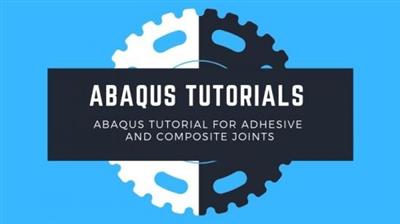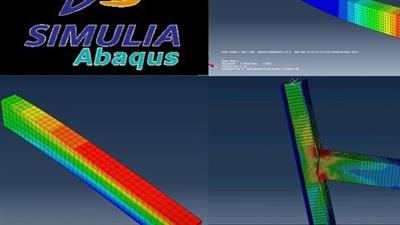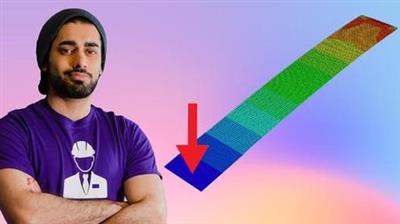Udemy - Adhesive Joints and Composite Material Abaqus Tutorial
"softddl.org"
21-02-2021, 20:21
-
Share on social networks:
-
Download for free: Udemy -
-

MP4 | Video: h264, 1280x720 | Audio: AAC, 44.1 KHz, 2 Ch
Genre: eLearning | Language: English + srt | Duration: 24 lectures (5h 13m) | Size: 3.1 GB
Adhesive Joints and Composite Materials

MP4 | Video: h264, 1280x720 | Audio: AAC, 44.1 KHz, 2 Ch
Genre: eLearning | Language: English + srt | Duration: 24 lectures (5h 13m) | Size: 3.1 GB
Adhesive Joints and Composite Materials
What you'll learn:
2D and 3D surface cohesive method
2D and 3D element cohesive method
How to model flexible adhesive
how to model bonded joint (DCB, ENF, SLJ)
2D and 3D XFEM method
Buckling and Post Buckling
Requirements
Students should have basic knowledge of Abaqus software as we are not explaining feature in this tutorial
The Last version of Abaqus
Description
Welcome to the Adhesive Joints and Composite Material Abaqus Tutorial, the only course you need to learn how to model adhesively bonded joint and composite material in Abaqus software. This course is specially designed for mechanical, civil engineering students or engineers who want to expand their finite element knowledge. This course will teach you the theory behind input parameters as well as modelling and analysing the results.
What you will get in this course:
**This Course is the divided into the 8 sections and in each section, I try to teach you sth new in each section so, in order to get the most advantage of it, I highly recommend you to follow the course in order as the basic terms have been only explained in the initial sections.
Section 1: 2D adhesively bonded DCB (cohesive element)
In this section, you will learn how to model two dimensional double cantilever beam (DCB) using cohesive element method.
Section 2: 2D Adhesively bonded SLJ (Surface-Based Cohesive)
In this section, you will learn how to model two dimensional Single-lap joint using surface-based cohesive zone.
Section 3: 3D adhesively bonded DCB (Cohesive element)
In this section, you will how model three dimensional double cantilever beam using cohesive element method.
Section 4: 2D adhesively bonded DCB (XFEM method)
In this section, you will become familiarize with eXtended finite element method (XFEM) to model two dimensional double cantilever beam.
Section 5: 2D adhesively bonded ENF (XFEM method)
In this section, you will learn how to model two dimensional end notched flexure beam using eXtended finite element method.
Section 6: 2D adhesively bonded ENF (Cohesive element method)
In this section, you will learn how to model two dimensional end notched flexure using cohesive element method.
Section 7: Flexible adhesive (New Update May 2020)
This is a new section is that I added to this course in May 2020, This section will help you to learn how to model flexible adhesive in Abaqus software. The following subjects will be discussed in this section: Hyper-elastic properties of flexible adhesive, Bulk flexible Specimen, Single-lap joint with flexible adhesive, Trapezoidal traction separation law for flexible adhesive.
Section 8: Buckling and Post Buckling of Composite Plate
This section will help you to learn how to composite plate and analyse buckling and post-buckling condition on the plate.
Future updates:
Composite tube under crushing compression loading, Composite plate under 3 point bending, Composite panel under impact loading, 3D composite single lap joint (Estimated new update January 2021).
I hope you all enjoy these tutorials. Please send me a message if you think anything can improve the quality of this course as I am updating the course regularly.
Many thanks
Armin
Who this course is for
Anyone who wants to learn how to model cohesive parameters in 2D, 3D, XFEM and modeling buckling in Abaqus software.
Homepage
https://www.udemy.com/course/abaqus-tutorial-intermediate/
Buy Premium From My Links To Get Resumable Support,Max Speed & Support Me

https://uploadgig.com/file/download/af91d03FF05aae68/kak37.Adhesive.Joints.and.Composite.Material.Abaqus.Tutorial.part1.rar
https://uploadgig.com/file/download/6119e781a56b9329/kak37.Adhesive.Joints.and.Composite.Material.Abaqus.Tutorial.part2.rar
https://uploadgig.com/file/download/cd8e1d286fb3E2a4/kak37.Adhesive.Joints.and.Composite.Material.Abaqus.Tutorial.part3.rar
https://uploadgig.com/file/download/cc9ec1871be70b79/kak37.Adhesive.Joints.and.Composite.Material.Abaqus.Tutorial.part4.rar

https://rapidgator.net/file/0d183e1743b619733ff2137aa94a6917/kak37.Adhesive.Joints.and.Composite.Material.Abaqus.Tutorial.part1.rar.html
https://rapidgator.net/file/01a378d16172ea9db2c29314be35ab57/kak37.Adhesive.Joints.and.Composite.Material.Abaqus.Tutorial.part2.rar.html
https://rapidgator.net/file/217d02c1d2141478900f7c171e177cc1/kak37.Adhesive.Joints.and.Composite.Material.Abaqus.Tutorial.part3.rar.html
https://rapidgator.net/file/50a4a2d3768ba25d5b3a21e01d0eb46e/kak37.Adhesive.Joints.and.Composite.Material.Abaqus.Tutorial.part4.rar.html

http://nitroflare.com/view/37824ED01633BD5/kak37.Adhesive.Joints.and.Composite.Material.Abaqus.Tutorial.part1.rar
http://nitroflare.com/view/F425961CC7EB6A2/kak37.Adhesive.Joints.and.Composite.Material.Abaqus.Tutorial.part2.rar
http://nitroflare.com/view/73A6D0141250092/kak37.Adhesive.Joints.and.Composite.Material.Abaqus.Tutorial.part3.rar
http://nitroflare.com/view/3158EEB81177C84/kak37.Adhesive.Joints.and.Composite.Material.Abaqus.Tutorial.part4.rar
Links are Interchangeable - No Password - Single Extraction
The minimum comment length is 50 characters. comments are moderated




